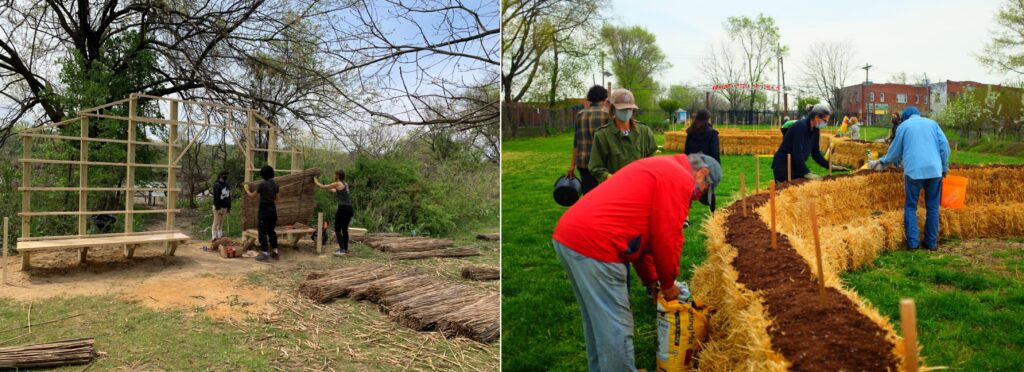The State We're In
Art and environment: Perfect together
Imagine if invasive plants like phragmites – the thick beds of reeds found in marshes – could be transformed into a work of art in the city of Camden? Or if a sculpture made up of straw bales in a formerly industrial Trenton neighborhood could grow food and become a beautiful gathering place for the community?
These two new projects are part of a unique art initiative taking place this spring through fall at parks and environmental centers in the Delaware River watershed in New Jersey, Pennsylvania and Delaware.
The Alliance for Watershed Education of the Delaware River, a network of organizations with missions related to water-based conservation and education, came up with the idea as a way to increase community engagement with land, water and nature. The Alliance commissioned Seattle-based environmental artist Sarah Kavage to create outdoor sculptures at 17 sites across the watershed.
The art is being built with natural materials relevant to each site, and is inspired by traditional building and craft practices like roof thatching, basket weaving, furniture making, and hair braiding. “Each material tells a different story about the watershed, the people in it, and the connections between land and water – and serve as metaphors for our current times,” says Sarah.
The project is known as the “Lenapehoking ~ Watershed,” a reference to both the Delaware River watershed and the land’s original inhabitants, the Lenape people.
The newest art installation, “Portal,” is underway at Gateway Park along the Cooper River in Camden. The piece consists of two benches connected by a large arch crafted of thatched phragmite reeds harvested from the site.
“At Gateway, the river is not really visible from the park because of the tree line that blocks the view,” explained Sarah. “I wanted to use this piece to encourage viewers to explore what’s beyond the trees, and to think about the experience of going through the portal as transformative.”
Visitors can walk beneath the arch to a pathway leading through the trees and down to the Cooper River. The experience is designed to transport them into another world that seems far from the noise and traffic of busy Admiral Wilson Boulevard, where the park is located.
The phragmites were collected in January 2020 during a Martin Luther King Day of Service event called “PhragFest,” attended by about 80 local volunteers. The reeds were then dried in preparation for the art project.
In Trenton, Sarah is creating another art installation at Capital City Farm, an urban farm next to the Trenton Area Soup Kitchen and a connector between the D&R Canal State Park and Assunpink Creek Greenway.
This project, titled “The Future is Open Ended,” is a beautifully designed giant straw bale garden that grows food and flowers, and provides an attractive community gathering place.
The straw bale garden was planted in late March with the assistance of volunteers, and will help Capital City Farm achieve its mission of becoming a community and educational space for the surrounding neighborhood.
The project references historic “redlining” in Trenton, the harmful practice of denying loans or services in certain neighborhoods based on race or ethnicity. Project proponents point to Capital City Farm as the type of investment in communities that can serve to “un-design the redline.”
“During the community input session for this project, people shared how they felt that this part of the city, on the border of East and North Trenton, had been punished by lines that other people put on a map,” said Sarah. “The design of the artwork responds to this conversation by attempting to create a space where people feel like they can envision and define their own future.”
Additional art projects have recently been completed at the Cobbs Creek Community Environmental Education Center in Philadelphia, the Berks Nature Center in Reading, Pa., and Tacony Creek Park in Philadelphia. Sarah will continue her work at the rate of one art installation a week until all 17 are finished.
Justin Dennis, Urban Parks Manager for New Jersey Conservation Foundation, is helping build and oversee the installations and hopes the art projects will attract community members who might not be interested in traditional nature education programs. “Art, compared to education, draws in a completely different audience, one coming from a different place in their heart,” explained Justin, a member of the Alliance for Watershed Education’s art work group.
All of the art installations are made of natural materials that decompose, and are temporary. The “Portal” arch in Camden, for example, will probably last only a year. The straw bale project in Trenton could last for two years, after which it will decompose and improve soil health on the farm
And this fall, artist Adrienne Mackey of Philadelphia will create a game to encourage people to visit the installations. Card decks designed by Adrienne will picture scenes from parks and environmental centers; each card will pose a challenge such as, “Go to the water’s edge and count how many birds you can see.”
For more information about the Alliance for Watershed Education and its art installations, visit https://www.watershedalliance.org/. To learn more about Sarah Kavage, go to http://www.kavage.com/.
And to learn more about preserving New Jersey’s land and natural resources, visit the New Jersey Conservation Foundation website at www.njconservation.org or contact me at info@njconservation.org.
About the Authors
Alison Mitchell
Co-Executive Director
John S. Watson, Jr.
Co-Executive Director
Tom Gilbert
Co-Executive Director, 2022-2023
Michele S. Byers
Executive Director, 1999-2021
View their full bios here.
Filter
Get The Latest News
From The Garden State
In the
News

